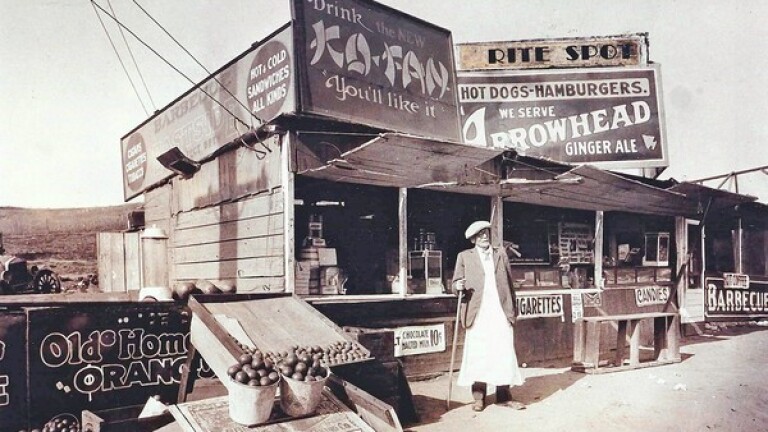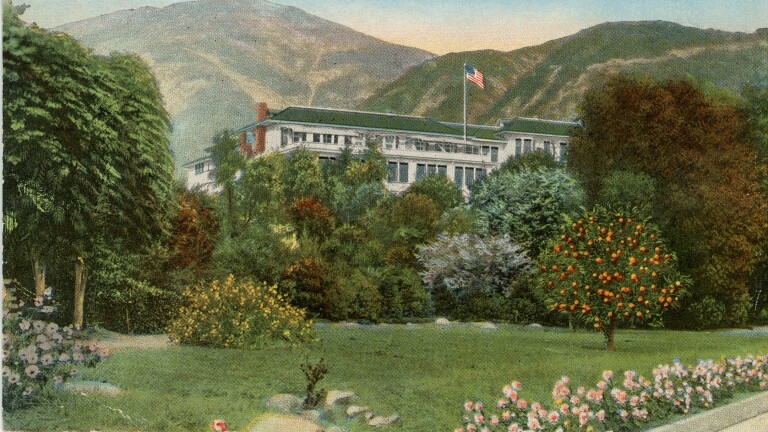Getting Lost in a Literary Adventure on Wheels

The Last Bookstore was already abuzz when cyclists began trickling in at noon on Sunday to gather for the Open Books "Lost Cyclist" ride. The farmer's market bustled outside on 5th Street, despite grey skies and an impending storm. It was a perfectly gloomy day, but in a city of ceaseless sun the change in the weather was welcomed. "Rain or shine," announced the event page on Facebook, and I was glad of it. Riding from bookstore to bookstore with a group of lit-loving cyclists sounded like an ideal way to spend a Sunday afternoon.
Hosted by the Feminist Library on Wheels (F.L.O.W.) in conjunction with the Bike Talk radio show (KPFK), Open Books rides are free public group rides that explore the city and its literary outposts. The inaugural ride spanned just under six miles, and encompassed three of Los Angeles's finest independent bookstores: The Last Bookstore in Downtown L.A., Stories in Echo Park, and Skylight Books in East Hollywood (four if you count Circus Books, though we didn't stop there). Future rides will take place in different parts of the city.
"Nick Richert of Bike Talk approached us with the idea, and had already thought through a plan for the first route," said Dawn Finley, a co-founder of F.L.O.W.
Established last summer, F.L.O.W. has grown into the robust mobile library it is now from a desire to establish a feminist library for the Women's Center for Creative Work (WCCW). At a WCCW reading group Finley met Jenn Witte, who is now Finley's partner in running F.L.O.W., and they found that they shared, along with their appreciation of feminist literature, a love of cycling. Witte lit up the idea of taking the library mobile on her bicycle, and Finley supported the idea wholeheartedly.
"The amount of support we've received in such a short time -- F.L.O.W. was just a twinkle in our eyes one year ago -- is validating," said Witte. "The most powerful moments for me are when I witness a person getting excited about taking home a feminist book, and often I know who donated it, and we get to help make that sharing happen in such a free and easy way."
F.L.O.W. brought its mobile library to more than a dozen events in the second half of 2014, but this event was the first of its kind for the fledgling organization.
"This event asked for a form of commitment from its participants different from other events so far," Wiite said. "I was touched by the number of people willing to ride that far for that long in the rain for the love of books, bikes and feminism."


Richert had arranged for a special event at the beginning of the ride: a chance to hear about the the adventures of the world's first cyclist to embark on a world tour, Frank Lenz, from author and bicycle scholar David Herlihy. Herlihy's book, "Lost Cyclist," details Lenz's foray into cycling at the turn of the 20th century, and his journey up until weeks before his mysterious death.
Through a series of photos and anecdotes, Herlihy described the newness of bicycles in America at the time, the niche cycling groups that formed around the subculture, the rugged road conditions and hefty bicycles that bicycle enthusiasts first grappled with, as well as the introduction of the "safety cycle," which eventually became the popular design for bicycles and still is today. Lenz was also a photographer, a field that was itself going through an exciting evolution at the turn of the century.
"If you were going to be a cycle photographer you'd have to bring a whole chemistry set," said Herlihy of the early 1890s, when Lenz was becoming more avid in both fields. In 1891 Lenz was offered an opportunity to take his camera and explore the continents on his bike by Outing Magazine, but they wanted him to ride a safety cycle. At first he was reluctant, preferring his high-wheel, but he couldn't pass up the opportunity.
"Lenz's trip helped to to popularize the safety," said Herlihy, adding that Lenz made a daring decision to equip his 47-pound safety cycle with pneumatic (inflatable) tires, which were also new and unproven at the time.
Unfortunately for Lenz, his trip ended when he was killed in Turkey. In the year of his disappearance, 1894, the great bicycle boom was picking up in the United States. Herlihy shared some photos taken by Will Sachtleben, one of the two cyclists who went to Turkey in search of Lenz. Herlihy had to take up his own search in order to uncover the details of Lenz's initial quest and Sachtleben's subsequent journey -- during this endeavor Herlihy discovered quite a few fascinating photos taken during these turn-of-the-century excursions. More than 40 of these original photos are the subject of Round Trip: Bicycling Asia Minor, an exhibit curated by Herlihy that is currently on display at the UCLA Fowler Museum.


Inspired by the adventures of Lenz and Sachtleben, the ride's attendees readied themselves for an adventure through a different kind of territory -- urban streets on a weekend, punctuated by stormy skies.
On a loaned bike Herlihy joined the group of a dozen cyclists, all of whom had layered up in preparation for the storm. The native Bostonian wore shorts and sandals, admittedly comfortable in Southern California's version of winter.
At Stories we were joined by Witte, who brought the F.L.O.W. library to the back of the bookstore in her car, as the customary trike and its contents would not do well in the rain. A bicycle section took up a table in the center of the store, and the patio out back gave us a nice place to warm up over coffee and chili, and chat about the evolution of bicycles and the intersections of cycling history and other historical events. During his search for Lenz, Sachtleben came to witness the beginnings of the Hamidian massacres in Turkey, and consequentially, took the first photos of crimes against humanity (in photographing the mass graves in Erzerum).
Outside we browsed the F.L.O.W. library and signed up for library cards. Books about cycling, feminism, women's history and LBGTQ rights made up much of the diverse collection. Built up through donations, the growing collection now vastly exceeds mobile capacity. Finley and Witte have made the full catalog available through LibraryThing. Books can be requested and will be brought to the next event F.L.O.W. attends.
"We know how many cardholders we have and how many books are on our shelves and how many books we've checked out, but F.L.O.W. clearly has its own life well beyond those things, and that's the best part," said Finley. "The circulation and community fostered by all the elements that make it come alive: feminism, cycling, books. Seeing those three things come together -- and how much joy that combination seems to bring people, lots of different kinds of people, for countless reasons -- has been a profound reward indeed."
The gloomy skies began to unleash steady raindrops as we departed from Stories. By the time we reached Skylight Books the storm was in full force, and the soggy fleet entered the bookstore in delight of the warm, bright space and all the literary treasures it contained.




